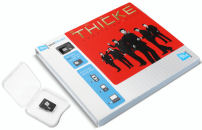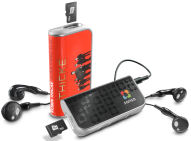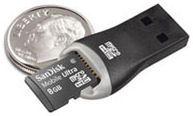Manifest Technology Blog
-- Site:
| Articles
| Galleries
| Resources
| DVI Tech
| About
| Site Map
|
Articles:
| PC Video
| Web Media
| DVD & CD
| Portable Media
| Digital Imaging
| Wireless Media
| Home Media
| Tech & Society
|
Portable Media:
| Portable Media Articles
| Portable Media Player Gallery
|
SanDisk slotMusic - A New Music Format (12/2008)
and slotRadio (1/2009)
by Douglas Dixon
The slotMusic Format
Why Another Physical Music Format
How Consumers Use MP3 Players
slotMusic Albums
Sansa slotMusic Player
slotRadio Cards and Sansa slotRadio Player
Find related SanDisk
articles in the Manifest Tech Blog
See my Portable Media
Players Gallery for for more on the Sansa slotMusic player and
other music and video players
The CD is fading away as a purchased music format, and digital music is growing,
but it's still clumsy to manage digital music files -- rip or purchase songs,
keep them organized, and then sync or download to the desired mobile phone or
portable players.
So maybe there's still a place for a new physical purchased music format --
the SanDisk slotMusic card, available for the 2008 holiday season with some 40 "albums" from major labels: EMI Music, Sony BMG Music, Universal
Music, and Warner Music (www.slotmusic.org).
The card plays in zillions of mobile phones with microSD slots, and can be
copied and played on PCs and other devices without any copy protection issues
(it's a standard microSD card with plain old MP3 files)..
And in January 2009, SanDisk introduced the next step in this theme, the slotRadio
card, packed with 1,000 songs, and intended to provide a
"radio-like" listening experience, so you can choose a genre or theme
and then listen to the professionally-selected playlist.
The slotMusic format is just a standard microSD card, preloaded with music
(plus additional content such as liner notes, album art, and videos). A typical
"album" on a 1 GB slotMusic card contains some 12 songs, and sells for
around $14.99, much like a CD.
 slotMusic "album" on microSD card
slotMusic "album" on microSD card
The music is in standard MP3 format, with good quality up to 320 kbps. And
it's DRM-free, without any copy protection, which means it should play on pretty
much any device. You can copy and play the music files on other devices
(including a PC -- they are packaged with a tiny USB adapter). And you can copy
your own files to the slotMusic cards -- again, they're just a standard microSD
card preloaded with MP3 and other files.
 SanDisk Sansa slotMusic Player
SanDisk Sansa slotMusic Player
SanDisk also has released an accompanying dead simple player device -- the SanDisk
Sansa slotMusic Player (www.sansa.com). It just plays MP3 and WMA music files from the
microSD slot -- there's no internal memory and no display. But a 16 GB card can
hold up to some 4,000 MP3 songs, which can keep you occupied for a while. The
player is small, under 2 ounces, and only $19.99.
Buying music on CDs (physical media, for heaven sakes!) is so 90's --
everybody knows that digital music is the future, right? But contrary to the
hype, CDs are far from dead. Like other research companies, Forrester Research
projects that the sales of digital music downloads will eventually overtake CD
sales -- but not until 2012.
www.dmwmedia.com/news/2008/02/19/report:-digital-music-download-sales-pass-cd-sales-2012
But Daniel Schreiber, manager of SanDisk's AV Business Unit, sees an alternative future for
music delivery. Speaking at the recent CDSA Media Market Intelligence Summit
in New York (www.contentdeliveryandstorage.org), Schreiber
said that the decline of the CD was not because people do not
want music in physical formats, but instead was the result of the demise of the
CD player -- Those shiny optical discs were so sexy when they were introduced,
but now are just too big for today's lifestyles. CDs no longer fit in our world
of hand-held devices, cell phones and PDAs.
 SanDisk microSD card with USB reader
SanDisk microSD card with USB reader
But SanDisk is already very active a physical storage format that does fit in these devices -- the
tiny microSD memory card (www.sandisk.com/Products/Catalog(1012)-Mobile_Memory.aspx).
SanDisk's ongoing Wake Up Your Phone marketing campaign has been
promoting the use of the memory card slot to add more storage capacity to your
mobile phone (www.wakeupyourphone.com).
So we have a storage format that's certinlay not too big (about the size of a pinky finger nail),
and explicitly designed for use in mobile devices, and easily accessed on PCs with a
SD card adapter. And some 80% of music-enabled mobile phones already sport a
microSD slot. Hmmm ...
So SanDisk, in partnership with the four major music labels, has introduced
the new slotMusic format (see previous post) -- music "albums" sold on
standard microSD cards.
 slotMusic card
slotMusic card
Again, slotMusic releases typically contains some 12 songs, and sell for around
$14.99, much like a CD. Even better, the music is stored in standard MP3 format,
without any copy protection, so you're free to copy it to other devices. And the
cards are standard 1 GB microSD flash memory, so they can be freely used to store any other data.
Schreiber said that 30 to 40 titles have been released in slotMusic format
(more than the first year of CD), available from SanDisk (plus the Sansa slotMusic
MP3 player), and from Best Buy and Wal-Mart (www.sansa.com/slotmusic_cards). Schreiber pointed to new releases
from Rihanna and Tim McGraw that already have seen 6% to 10% of sales on
slotMusic.
But do consumers need this new format? And doesn't digital music make physical
formats obsolete?
As manager of SanDisk's AV Business Unit, which includes the Sansa line of media
players (a clear #2 in the market behind the iPod), Daniel Schreiber is very interested
in how consumers access their music and use their music players.
His research shows that consumers still like tangible, physical connections
to their music, not just in how it is delivered, but also in photos and t-shirts
and even by saving ticket stubs. After all, the paperless office has not
eliminated paper, and, even in this digital networked age, USB drives are still
very popular for physically moving and storing data.
And for digital music, Schreiber says that the process is still much too
difficult -- finding, purchasing and downloading tracks, and then connecting up
the player and synchronizing the new music. As a result, discussions with
consumers show that many people with MP3 players simply do not do downloading.
Instead, there is typically a designated loader in the household (I guess much
like the designated PC support person in your family).
Schreiber's data shows that some 90% of women with an iPod do not load it
themselves. He cited examples of people who said that they were very happy with
their player, and could not think of anything to improve it, and yet still were
listening to the same 20 songs that a friend initially loaded for them, or who
shipped their player to a family member every six months in order to load it
with new music.
In comparison, Schreiber sees slotMusic as a convenient format for allowing
consumers to easily access and play their favorite music. And there's a lot of
places that these cards can be used -- some 500,000 mobile phones shipped list
year with microSD slots, and another 750,000 will ship this year, for a total of
over a billion portable handheld music-playing devices ready to play music
(compare that to the number of CD players available in the infancy of that
format).
Schreiber concluded his presentation by stressing the continued power of flash memory, which
has has seen the pricing reduced 10,000X in the 18 years it has been available.
In the late 90s, flash memory replaced chemical film in digital cameras, and
more recently USB drives have replaced the floppy disk in computers. And we are
now starting to see the Solid State Drive (SSD) doing the same to hard disks,
especially in notebooks.
Schreiber echoed the Einstein quote, "The most powerful force in the
universe is compound interest," looking forward to further compounding of
the potential of flash memory. For example, through adding intelligence to the
memory, not only for applications like built-in security and DRM, but even
including a Web server to provide networked access to storage within a phone and
network.
The idea behind the slotMusic card format is to provide easy access for
playing your music (www.sansa.com/slotmusic_cards). Since the format uses standard microSD memory cards that
contain standard MP3 files stored with no copy protection, the cards are readily playable in billions of mobile phones with microSD
slots, the files can be copied to other devices, and the card can be used for
other data storage.
 Robert Thicke slotMusic "album"
Robert Thicke slotMusic "album"
For example, the slotMusic version of the Robert Thicke album, Someting
Else,
has a Music folder with the 12 MP3 tracks, plus additional bonus material
(readable on a PC): an Extras folder
with a few photos of Thicke and a Video folder with three music clips and an
interview. With the music, only 530 MB is used on the 1 GB card, so almost half the capacity is
still available.
(The photos are a mix of low and high res, JPEG and TIF. The videos are
each in three formats: 3GP for phones, MP4 for PC playback, and AVI for the
Sansa Fuze.)
The slotMusic titles are packaged in a CD-sized case with a slide-out plastic
insert. The case has front and back album cover art and information, with a
small booklet inside the back. The plastic insert has a perforated tab to rip
open easily -- but then has no provision for closing it back up to store your
music. SanDisk says this is a known issue, and the product should have a way to
store the card conveniently in the CD case packaging.
The plastic insert contains the slotMusic card with the music, a small
plastic storage case, and a mini USB adapter. The storage case has the front
cover album art to identify it, which is important because the card itself does
not identify its contents -- It just has the slotMusic and microSD logos, not
the album or artist information.
To play the music, slip the slotMusic card into your mobile phone or other
portable device, or onto your PC (using the included USB adapter).
If you want a separate playback device, there's also the new SanDisk Sansa
slotMusic Player (www.sansa.com/players/sansa_slotmusic). It's designed to be simple and inexpensive ($19.99), since it
just plays microSD cards -- there's no internal memory and no display.
 SanDisk Sansa slotMusic Player
SanDisk Sansa slotMusic Player
The player has simple controls -- play/stop, forward/reverse, and volume
up/down. The slot in the player is on one end, and is spring-loaded, so the card
inserts firmly and is recessed in the player body.
There's also no PC / USB interface for transferring files (that's what the
microSD card is for) -- or for recharging an internal battery. Instead, the
player uses a removable AAA battery, so it's significantly huskier than the iPod
shuffle and other minimalist players.
For big music fans, SanDisk offers bundles with a slotMusic album and
associated slotMusic Player for $34.99 -- with the player customized with the
album art.
The slotMusic format is a nice way of delivering no-fuss digital music, but
putting only 10 or so songs on a microSD card is a huge waste of space in an era
of multi-gigabyte cards. And carrying around music on the tiny cards and
swapping them on the go could be something of a pain.
Instead, the SanDisk slotRadio card format, announced in January 2009,
fills a card with a thousand songs, professionally selected and pre-organized
into genres and themes (www.sansa.com/slotRadio_cards).
The idea is to present a lean-back "radio-like" experience -- you just
select the type of music that you're interested in hearing, and the playlist is
ready to go.
 slotRadio card
slotRadio card
SanDisk is releasing the SanDisk Sansa slotRadio Player in early 2009
to play this new format for $99.99, including a 1,000-song card (www.sansa.com/players/sansa_slotRadio).
The slotRadio mix card will have around 10 genres (rock, contemporary, country),
so you can choose the style of music to fit your mood and then just enjoy.
Additional cards will be available for $39.99, with all 1,000 songs selected for
a specific genre or theme.
 SanDisk Sansa slotRadio Player
SanDisk Sansa slotRadio Player
However, unlike the slotMusic format, the slotRadio cards will be copy
protected (with SanDisk TrustedFlash, www.sandisk.com/OEM/Default.aspx?CatID=1639).
The format initially will only be playable in the Sansa slotRadio Player and
the Sansa Fuse player, and not on the the older View and Clip models (www.sansa.com).
SanDisk is also working with mobile phone vendors to support the slotRadio
format in new models -- both the DRM and the slotRadio interface to access the
music.
|
